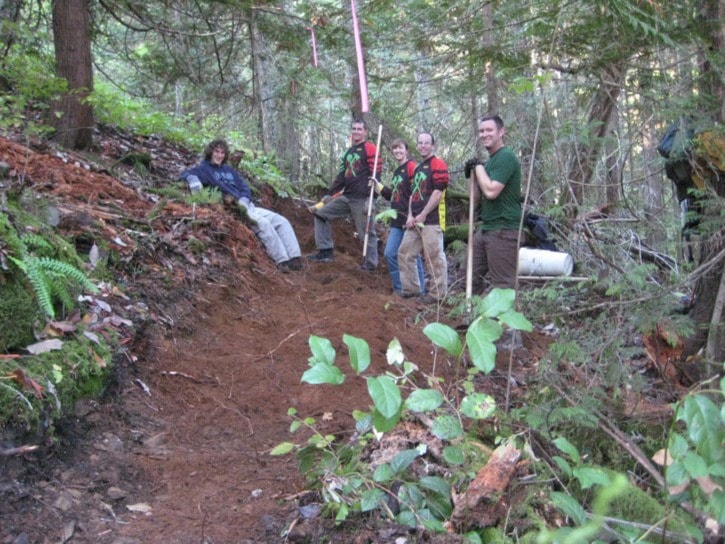On a bright, chilly morning in October, five members of the Sooke Bike Club made the trip to Hartland Mountain Bike Park to both assist the Hartland Trail crew in building a long overgrown trail, and to learn some techniques to bring back to Sooke, which the club will start to apply once Harbourview Park officially opens.
Lorien Arnold, SBC member and owner of Sooke Mountain Cycle, has had a long history with the trail in question going back about 14 years to when the line was first laid in by a couple of fellows he used to ride with. Trillium Trail was a line they used to ride long before there was a parking lot, and the surplus land around Hartland landfill was only accessible via Durrance Lake road or by the firehall off Munns road.
After unloading all the tools, the group started up the regional trail. Craig Gillette filled Arnold in on the task at hand, who became excited at the thought of resurrecting a trail he hadn’t ridden or much less thought about in over a decade.
Once debriefed, the Sookies were segregated from the rest of the group and marched up the trail to a challenging 25 or so metre section, deep in the cedars traversing a significantly steepish sidehill, dotted with decomposed rock and buried, rotten timber. Craig laid out his plan, and then everyone got to work.
The organic top coat and loam were scraped from the line, some pruning done, and all the rotting timber removed. Getting down to mineral soil was a challenge, due mainly to the multitude of cedar roots — the springy spindly roots, which catch in the rake, doubled the effort. The other difficulty was the buried cedar logs under the soil, which needed to be dug out and filled with rock in order to keep the trail from developing potholes and collapsing.
A difficulty in building side hill trail is drainage. The crew installed drainage dips and berms to help direct water off the trail in ways which would allow the water to sheet instead of flow in a concentrated stream. Because there was significant slope, much of it thin soil over rock, above the trail, it was evident this piece of trail would have to handle a lot of water. Once down to mineral soil, with the drainage structures in place, The trail was outsloped and tamped as much as possible. Due to the dry conditions, much of the soil was dusty, but a few days of rain will help get the tread established.
There was one big hurdle to overcome, and that was to deal with a line which was downslope from some big cedars. Opening a line below a root structure does a couple of bad things; for one, it exposes a root system, which will shock the tree and often kill it. Secondly, it can create a dangerous situation for riders in that they have to ride over diagonal, off camber roots which get really slick in the wet. The solution? With Craig’s blessing, the line was rerouted through a little rock envelope, opening up an opportunity to build a techical little berm leading into a little jump. It’s little things that often add spice and interest to a trail, things one might not notice much when riding a trail, but that add to the experience.
Building a trail is not simply a physical thing. In order to build an appealing trail, with flow, the builder must consider the psychology of the trail user. Using gateways, anchors and control points mindfully, a trail builder can take their line and make for an exceptional experience. This is a skill that the Hartland Trail Crew has carefully developed in over a decade of trail work, providing users with a good experience through careful design and sustainable building practices.
